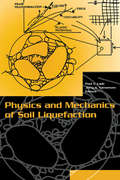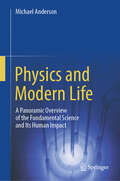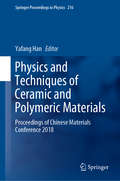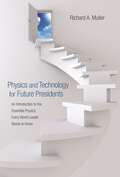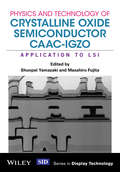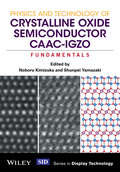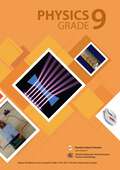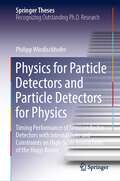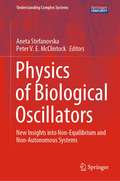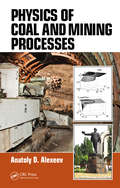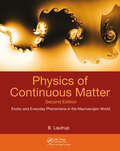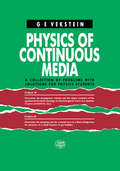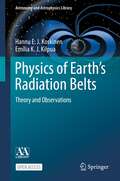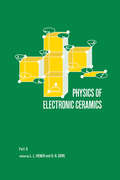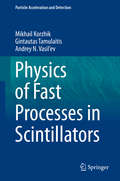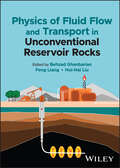- Table View
- List View
Physics and Mechanics of New Materials and Their Applications: Proceedings of the International Conference PHENMA 2020 (Springer Proceedings in Materials #10)
by Shun-Hsyung Chang Ivan A. Parinov Yun-Hae Kim Nao-Aki NodaThis book presents selected peer-reviewed contributions from the 2020 International Conference on “Physics and Mechanics of New Materials and Their Applications”, PHENMA 2020 (26–29 March 2021, Kitakyushu, Japan), focusing on processing techniques, physics, mechanics, and applications of advanced materials. The book describes a broad spectrum of promising nanostructures, crystal structures, materials, and composites with unique properties. It presents nanotechnological design approaches, environmental-friendly processing techniques, and physicochemical as well as mechanical studies of advanced materials. The selected contributions describe recent progress in computational materials science methods and algorithms (in particular, finite-element and finite-difference modelling) applied to various technological, mechanical, and physical problems. The presented results are important for ongoing efforts concerning the theory, modelling, and testing of advanced materials. Other results are devoted to promising devices with higher accuracy, increased longevity, and greater potential to work effectively under critical temperatures, high pressure, and in aggressive environments.
Physics and Mechanics of New Materials and Their Applications: Proceedings of the International Conference PHENMA 2021-2022 (Springer Proceedings in Materials #20)
by Shun-Hsyung Chang Ivan A. Parinov Arkady N. SolovievThis book presents 50 selected peer-reviewed contributions from the 10th Anniversary International Conference on “Physics and Mechanics of New Materials and Their Applications”, PHENMA 2021-2022 (23-27 May, 2022, Divnomorsk, Russia), focusing on processing techniques, physics, mechanics, and applications of advanced materials. The book describes a broad spectrum of promising nanostructures, crystal structures, materials, and composites with unique properties. It presents nanotechnological design approaches, environmental-friendly processing techniques, and physicochemical as well as mechanical studies of advanced materials. The selected contributions describe recent progress in computational materials science methods and algorithms (in particular, finite-element and finite-difference modelling) applied to various technological, mechanical, and physical problems. The presented results are important for ongoing efforts concerning the theory, modelling, and testing of advanced materials. Other results are devoted to promising devices with higher accuracy, increased longevity, and greater potential to work effectively under critical temperatures, high pressure, and in aggressive environments.
Physics and Mechanics of New Materials and Their Applications: Proceedings of the International Conference PHENMA 2023 (Springer Proceedings in Materials #41)
by Shun-Hsyung Chang Ivan A. Parinov Erni Puspanantasari PutriThis book presents 60 selected peer-reviewed contributions from the international conference Physics and Mechanics of New Materials and Their Applications, PHENMA 2023 (3-8 October, 2023, Surabaya, Indonesia), focusing on processing techniques, physics, mechanics, and applications of advanced materials. The book describes a broad spectrum of promising nanostructures, crystal structures, materials, and composites with unique properties. It presents nanotechnological design approaches, environmental-friendly processing techniques, and physicochemical as well as mechanical studies of advanced materials. The selected contributions describe recent progress in energy harvesting and piezoelectric materials optimization, electromagnetoelastic actuators for nanotechnology research, impedance spectroscopy and study of ceramic materials, catalyst synthesis and control of morphological characteristics, synthesis and study of electrocatalysts for fuel cells. The presented results are important forongoing efforts concerning the theory, modelling, and testing of advanced materials. Other results are devoted to the analysis of technogenic raw materials and different material applications in science, technique and industry.
Physics and Mechanics of New Materials and Their Applications: Proceedings of the International Conference PHENMA 2024 (Springer Proceedings in Materials #3)
by Shun-Hsyung Chang Ivan A. Parinov Vijay Kumar Gupta Nagendra SohaniThe book provides new results of internationally recognized scientific teams in the fields of Materials Science, Physics, Mechanics, Fabrication Techniques and Technologies of Advanced Materials, operating in wide scaling from nanometer to macroscopic range. The developed theoretical and experiment approaches cover prospective manufacture methods of nanomaterials, ferroelectrics, piezoelectrics (environmentally friendly) and other advanced materials and composites. The book discusses fabrication techniques, physics, mechanics, and applications of promising materials and composites. It presents numerous results of theoretical and experimental studies of novel materials and devices with beforehand given and improved structure-sensitive properties, based on the methods of biology, inorganic and organic chemistry, magnetoelectric elasticity, physics of condensed matter and material science. Thus, the book allows one to better understand the modern requirements for advanced materials and composites. The results obtained also include computational algorithms and original hard- and software, used in realization of numerical methods (in particular, finite-element modeling), demonstrating fascinating new advancements for wide spectrum of novel materials (which could be obtained due to reprocessing or using natural materials, wastes, fruits and plants) and devices. The advanced materials with specific properties and novel devices, based on them, show higher and improved properties in comparison with the properties of the competitive publications. In the result, it gives a new knowledge, which is necessary for numerous applications and subsequent development of industry and the methods of management and marketing. The original theoretical, numerical and experiment methods, manufactured devices and set-ups demonstrate significant possibilities in expanding the research of various physical processes and phenomena. They provide different improvements in the study of numerous structure-sensitive characteristics of solids and structures. The book will be useful for students, post-graduate students, scientists and engineers, which research and develop a new generation of nanomaterials and nanocomposites, ferroelectric and piezoelectric materials, other promising structures and compositions with structure-sensitive properties, and various devices, designed on their base and used in different applications of science, technique and technology. Moreover, it will be very interesting for specialists, working in industry, management and marketing. The book is important for unification and development of various expertise, designs and studies. It presents new research methods and scientific results in the Condensed Matter Physics, Materials Science, Physical and Mechanical Experiment, Processing Techniques and Engineering of Nanomaterials, Piezoelectrics and other Advanced Materials and Composites, Computational Methods, numerous applications and developed devices.
Physics and Mechanics of Soil Liquefaction
by Poul V. Lade Jerry A. YamamuroThe workshop aims to provide a fundamental understanding of the liquefaction process, necessary to the enhancement of liquefaction prediction. The contributions are divided into eight sections, which include: factors affecting liquefaction susceptibility and field studies of liquefaction.
Physics and Modern Life: A Panoramic Overview of the Fundamental Science and Its Human Impact
by Michael AndersonThis book introduces physics concepts and principles at a conversant but non-technical level. It also explores technology, with particular focus on two overarching themes that largely define modern life: our intensified use of energy and digital information. These themes take up several entire chapters (“Human Use of Chemical Fuel,” “Computers,” and “Light and Telecommunications”) and substantial parts of several others (e.g., sections on satellites and GPS, telegraph and telephone networks, generators and transformers, nuclear power, and solid-state technologies). The themes of energy and information highlight the pertinence of physics and facilitate a big-picture understanding of how life today differs from that of two hundred or two thousand years ago. The book grew out of lecture notes for a one-semester college physics course for non-science majors, so it could be useful to instructors and students of similar courses. The abundance of material offers some freedom in the design of such a course. However, the author hopes that the combination of conceptual depth and informal tone will appeal to a more diverse audience united by a genuine curiosity regarding science and technology. That audience might include pursuers of continuing education as well as physics majors looking for a lighter conceptual supplement to give context to their more technical coursework.
Physics and Psychics: The Occult and the Sciences in Modern Britain (Science in History)
by Richard NoakesThis is the first systematic exploration of the intriguing connections between Victorian physical sciences and the study of the controversial phenomena broadly classified as psychic, occult and paranormal. These phenomena included animal magnetism, spirit-rapping, telekinesis and telepathy. Richard Noakes shows that psychic phenomena interested far more Victorian scientists than we have previously assumed, challenging the view of these scientists as individuals clinging rigidly to a materialistic worldview. Physicists, chemists and other physical scientists studied psychic phenomena for a host of scientific, philosophical, religious and emotional reasons, and many saw such investigations as exciting new extensions to their theoretical and experimental researches. While these attempted extensions were largely unsuccessful, they laid the foundations of modern day explorations of the connections between physics and psychic phenomena. This revelatory study challenges our view of the history of physics, and deepens our understanding of the relationships between science and the occult, and science and religion.
Physics and Techniques of Ceramic and Polymeric Materials: Proceedings of Chinese Materials Conference 2018 (Springer Proceedings in Physics #216)
by Yafang HanThis book gathers selected papers from the Chinese Materials Conference 2018 (CMC2018) held in Xiamen City, Fujian, China, on July 12–16, 2018. The Chinese Materials Conference (CMC) is the Chinese Materials Research Society’s most important conference series and has been held annually since the early 1990s. The 2018 edition consisted of 32 domestic symposia, 2 international symposia and 1 international materials forum. This proceedings book covers the fields of advanced ceramic materials and polymer materials, and presents recent original research results from more than 300 research groups in various universities and research institutes.
Physics and Technology for Engineers: Understanding Materials and Sustainability
by R. PrasadThis textbook covers the physics of engineering materials and the latest technologies used in modern engineering projects. It has been designed for use as a reference book and course material for undergraduate engineering students. The book was born out of the need for a comprehensive, balanced, and up-to-date guide for teaching physics to beginning undergraduate engineering students and creating examination papers for technical boards and institutes. The text is divided into ten chapters, each with its specific objectives and features. The topics covered include the classification of engineering materials, atomic structure, electrical and magnetic behavior of solids, quantum mechanics, laser technology, nanomaterials, and sustainable development.Authored by a physicist with over 40 years of teaching experience, this richly-illustrated textbook features an abundance of self-assessment questions, solved examples, and a variety of chapter-end questions with detailed answers. The textbook starts from the very basics and is developed to the desired level, thus making it ideal as standalone course material.
Physics and Technology for Future Presidents: An Introduction to the Essential Physics Every World Leader Needs to Know
by Richard A. MullerPhysics for future world leadersPhysics and Technology for Future Presidents contains the essential physics that students need in order to understand today's core science and technology issues, and to become the next generation of world leaders. From the physics of energy to climate change, and from spy technology to quantum computers, this is the only textbook to focus on the modern physics affecting the decisions of political leaders and CEOs and, consequently, the lives of every citizen. How practical are alternative energy sources? Can satellites really read license plates from space? What is the quantum physics behind iPods and supermarket scanners? And how much should we fear a terrorist nuke? This lively book empowers students possessing any level of scientific background with the tools they need to make informed decisions and to argue their views persuasively with anyone—expert or otherwise.Based on Richard Muller's renowned course at Berkeley, the book explores critical physics topics: energy and power, atoms and heat, gravity and space, nuclei and radioactivity, chain reactions and atomic bombs, electricity and magnetism, waves, light, invisible light, climate change, quantum physics, and relativity. Muller engages readers through many intriguing examples, helpful facts to remember, a fun-to-read text, and an emphasis on real-world problems rather than mathematical computation. He includes chapter summaries, essay and discussion questions, Internet research topics, and handy tips for instructors to make the classroom experience more rewarding.Accessible and entertaining, Physics and Technology for Future Presidents gives students the scientific fluency they need to become well-rounded leaders in a world driven by science and technology.Leading universities that have adopted this book include:HarvardPurdueRice UniversityUniversity of ChicagoSarah Lawrence CollegeNotre DameWellesleyWesleyanUniversity of ColoradoNorthwesternWashington University in St. LouisUniversity of Illinois - Urbana-ChampaignFordhamUniversity of MiamiGeorge Washington UniversitySome images inside the book are unavailable due to digital copyright restrictions.
Physics and Technology of Crystalline Oxide Semiconductor CAAC-IGZO: Application to Displays
by Shunpei Yamazaki Tetsuo TsutsuiThis book highlights the display applications of c-axis aligned crystalline indium-gallium-zinc oxide (CAAC-IGZO), a new class of oxide material that challenges the dominance of silicon in the field of thin film semiconductor devices. It is an enabler for displays with high resolution and low power consumption, as well as high-productivity manufacturing. The applications of CAAC-IGZO focus on liquid crystal displays (LCDs) with extremely low power consumption for mobile applications, and high-resolution and flexible organic light-emitting diode (OLED) displays, and present a large number of prototypes developed at the Semiconductor Energy Laboratory. In particular, the description of LCDs includes how CAAC-IGZO enables LCDs with extremely low refresh rate that provides ultra-low power consumption in a wide range of use cases. Moreover, this book also offers the latest data of IGZO. The IGZO has recently achieved a mobility of 65.5 cm2?}V-s, and it is expected to potentially exceed 100 cm2?}V-s as high as that of LTPS. A further two books in the series will describe the fundamentals of CAAC-IGZO, and the application to LSI devices. Key features: * Introduces different oxide semiconductor field-effect transistor designs and their impact on the reliability and performance of LCDs and OLED displays, both in pixel and panel-integrated driving circuits. * Reviews fundamentals and presents device architectures for high-performance and flexible OLED displays, their circuit designs, and oxide semiconductors as an enabling technology. * Explains how oxide semiconductor thin-film transistors drastically can improve resolution and lower power consumption of LCDs.
Physics and Technology of Crystalline Oxide Semiconductor CAAC-IGZO: Application to LSI
by Shunpei Yamazaki Masahiro FujitaThis book describes the application of c-axis aligned crystalline In-Ga-Zn oxide (CAAC-IGZO) technology in large-scale integration (LSI) circuits. The applications include Non-volatile Oxide Semiconductor Random Access Memory (NOSRAM), Dynamic Oxide Semiconductor Random Access Memory (DOSRAM), central processing unit (CPU), field-programmable gate array (FPGA), image sensors, and etc. The book also covers the device physics (e.g., off-state characteristics) of the CAAC-IGZO field effect transistors (FETs) and process technology for a hybrid structure of CAAC-IGZO and Si FETs. It explains an extremely low off-state current technology utilized in the LSI circuits, demonstrating reduced power consumption in LSI prototypes fabricated by the hybrid process. A further two books in the series will describe the fundamentals; and the specific application of CAAC-IGZO to LCD and OLED displays. Key features: * Outlines the physics and characteristics of CAAC-IGZO FETs that contribute to favorable operations of LSI devices. * Explains the application of CAAC-IGZO to LSI devices, highlighting attributes including low off-state current, low power consumption, and excellent charge retention. * Describes the NOSRAM, DOSRAM, CPU, FPGA, image sensors, and etc., referring to prototype chips fabricated by a hybrid process of CAAC-IGZO and Si FETs.
Physics and Technology of Crystalline Oxide Semiconductor CAAC-IGZO: Fundamentals
by Shunpei Yamazaki Noboru KimizukaElectronic devices based on oxide semiconductors are the focus of much attention, with crystalline materials generating huge commercial success. Indium-gallium-zinc oxide (IGZO) transistors have a higher mobility than amorphous silicon transistors, and an extremely low off-state current. C-axis aligned crystalline (CAAC) IGZO enables aggressive down-scaling, high reliability, and process simplification of transistors in displays and LSI devices. This original book introduces the CAAC-IGZO structure, and describes the physics and technology of this new class of oxide materials. It explains the crystallographic classification and characteristics of crystalline oxidesemiconductors, their crystallographic characteristics and physical properties, and how this unique material has made a major contribution to the field of oxide semiconductor thin films. Two further books in this series describe applications of CAAC-IGZO in flat-panel displays and LSI devices. Key features: Introduces the unique and revolutionary, yet relatively unknown crystalline oxide semiconductor CAAC-IGZO Presents crystallographic overviews of IGZO and related compounds. Offers an in-depth understanding of CAAC-IGZO. Explains the fabrication method of CAAC-IGZO thin films. Presents the physical properties and latest data to support high-reliability crystalline IGZO based on hands-on experience. Describes the manufacturing process the CAAC-IGZO transistors and introducesthe device application using CAAC-IGZO.
Physics class 9 - MIE
by Mauritius Institute of EducationThe textbook offers a comprehensive overview of Grade 9 Physics from the Mauritius Institute of Education, specifically focusing on the Measurement in Science unit. It includes information on contributors involved in the textbook's creation and review, curriculum alignment with national standards, and an emphasis on incremental content development and scientific skills from previous grades. Learning tools provided encompass inquiry-based activities, summaries, "Find out" features, "Did you know?" sections, project work suggestions, unit summaries, and concept maps for effective learning and assessment. The unit itself covers the measurement of physical quantities such as length, volume, mass, time, and temperature, offering detailed explanations, error avoidance techniques, and practical activities to aid comprehension.
Physics for Anesthesiologists and Intensivists: From Daily Life to Clinical Practice
by Antonio PisanoThis book, now in its 2nd edition, discusses, explains and provides detailed, up-to-date information on physics applied to clinical practice in anesthesiology and critical care medicine, with the aid of simple examples from daily life. Almost everything that happens around us, including in the operating room and intensive care units, can be explained by physical laws. An awareness and understanding of relatively simple laws such as the Hagen-Poiseuille equation, or of slightly more complex topics such as harmonic motion and electromagnetism, to name just a few, offer anesthesiologists and intensivists fascinating insights into why they do what they do.After an introductory chapter that brushes up on all the (few) mathematics the reader will need to face the book, with many practical examples and clinical applications, each of the following 20 chapters deals with some everyday phenomena, explains them with one or more physical laws, and shows why these laws are important in anesthesia and critical care practice. Many illustrations are included for extra clarity. This enriched and updated edition of Physics for Anesthesiologists is intended for anesthesiologists, intensivists, anesthesia and intensive care medicine teachers and trainees, as well as medical students.
Physics for Particle Detectors and Particle Detectors for Physics: Timing Performance of Semiconductor Detectors with Internal Gain and Constraints on High-Scale Interactions of the Higgs Boson (Springer Theses)
by Philipp WindischhoferExperimental particle physics is a science of many scales. A large number of physical processes spanning energies from meV to TeV must be understood for modern collider experiments to be designed, built, and conducted successfully. This thesis contributes to the understanding of phenomena across this entire dynamic range. The first half of this document studies aspects of low-energy physics that govern the operation of particle detectors, limit their performance, and guide the development of novel instrumentation. To formalise these aspects, classical electrodynamics is used to derive a general description of the formation of electrical signals in detectors, and ideas from quantum mechanics are applied to the study of charge avalanche amplification in semiconductors. These results lead to a comprehensive analytical characterisation of the time resolution and the efficiency of single-photon avalanche diodes, and isolate the most important design variables. They also reveal the applicability of these devices in precision timing detectors for charged particles, which is experimentally verified in a high-energy hadron beam. Large detector systems at hadron colliders probe fundamental physics at the energy frontier. In the second half, data collected with the ATLAS detector during Run 2 of the Large Hadron Collider are used to measure the cross-section for the production of a Higgs boson together with an electroweak boson as a function of the kinematic scale of the process. This measurement provides the finest granularity available to date for this process. It is highly informative of the structure of interactions beyond the direct kinematic reach of the experiment, and new limits are set on the couplings of such interactions within an effective field theory.
Physics of Biological Oscillators: New Insights into Non-Equilibrium and Non-Autonomous Systems (Understanding Complex Systems)
by Aneta Stefanovska Peter V. E. McClintockThis book, based on a selection of invited presentations from a topical workshop, focusses on time-variable oscillations and their interactions. The problem is challenging, because the origin of the time variability is usually unknown. In mathematical terms, the oscillations are non-autonomous, reflecting the physics of open systems where the function of each oscillator is affected by its environment. Time-frequency analysis being essential, recent advances in this area, including wavelet phase coherence analysis and nonlinear mode decomposition, are discussed. Some applications to biology and physiology are described.Although the most important manifestation of time-variable oscillations is arguably in biology, they also crop up in, e.g. astrophysics, or for electrons on superfluid helium. The book brings together the research of the best international experts in seemingly very different disciplinary areas.
Physics of Coal and Mining Processes
by Anatoly D. AlexeevAround the world, on average, four coal miners die for each million tons of coal recovered. Improving the safety of mining work while responding to the need for increased coal production, however, is impossible without further development of the physics of mining processes. A relatively new branch of science, it tackles problems that arise during m
Physics of Continuous Matter: Exotic and Everyday Phenomena in the Macroscopic World
by B. LautrupPhysics of Continuous Matter: Exotic and Everyday Phenomena in the Macroscopic World, Second Edition provides an introduction to the basic ideas of continuum physics and their application to a wealth of macroscopic phenomena. The text focuses on the many approximate methods that offer insight into the rich physics hidden in fundamental continuum me
Physics of Continuous Media: A Collection of Problems With Solutions for Physics Students
by G.E. VeksteinThis textbook is based on lectures and tutorials given for several years at the Physics Department of Novosibirsk State University. It is constructed as a set of problems followed by detailed solutions and may act as a complementary text for standard courses on the physics of continuous media.
Physics of Daily Life First Semester FYBA, B.COM, B.SC New NEP Syllabus - SPPU
by Dr R. B. Bhise Dr A. B. Bhorde Dr M. S. Shinde Dr M. D. Dhiware R. G. Waykar Dr T. P. Gujar"Physics of Daily Life" is an introductory textbook designed for first-year undergraduate students (B.Sc., B.A., and B.Com) following the National Education Policy (NEP) syllabus of 2024. The book simplifies fundamental physics concepts and demonstrates their applications in everyday life, making them accessible to students from diverse academic backgrounds. It covers various topics, including atmospheric physics, human body mechanics, sports physics, and technological applications. The book explains physical principles like Pascal’s law, Archimedes’ principle, and Rayleigh scattering, alongside their real-world implications, such as weather systems, optical instruments, and modern technologies like GPS, lasers, and electric motors. Written in a clear and structured manner, it integrates theoretical explanations with practical examples to enhance comprehension.
Physics of Earth’s Radiation Belts: Theory and Observations (Astronomy and Astrophysics Library)
by Hannu E. Koskinen Emilia K. KilpuaThis open access book serves as textbook on the physics of the radiation belts surrounding the Earth. Discovered in 1958 the famous Van Allen Radiation belts were among the first scientific discoveries of the Space Age. Throughout the following decades the belts have been under intensive investigation motivated by the risks of radiation hazards they expose to electronics and humans on spacecraft in the Earth’s inner magnetosphere. This textbook teaches the field from basic theory of particles and plasmas to observations which culminated in the highly successful Van Allen Probes Mission of NASA in 2012-2019. Using numerous data examples the authors explain the relevant concepts and theoretical background of the extremely complex radiation belt region, with the emphasis on giving a comprehensive and coherent understanding of physical processes affecting the dynamics of the belts. The target audience are doctoral students and young researchers who wish to learn about the physical processes underlying the acceleration, transport and loss of the radiation belt particles in the perspective of the state-of-the-art observations.
Physics of Electronic Ceramics, (2 Part)
by L. L. HenchThis book includes papers, presented at a conference held at the University of Florida in 1969, on aspects of the technology of electronic ceramics in terms of the underlying science upon which the technology depends. It is intended for users of electronic ceramics and teachers in this field.
Physics of Fast Processes in Scintillators (Particle Acceleration and Detection)
by Mikhail Korzhik Gintautas Tamulaitis Andrey N. Vasil'evThis book presents the current advances in understanding of the fast excitation transfer processes in inorganic scintillation materials, the discovery of new materials exhibiting excellent time resolution, and the results on the evaluation of timing limits for scintillation detectors. The book considers in-depth basic principles of primary processes in energy relaxation, which play a key role in creating scintillating centers to meet a growing demand for knowledge to develop new materials combining high energy and time resolutions. The rate of relaxation varies. However, the goal is to make it extremely fast, occurring within the ps domain or even shorter. The book focuses on fast processes in scintillation materials. This approach enables in-depth understanding of fundamental processes in scintillation and supports the efforts to push the time resolution of scintillation detectors towards 10 ps target. Sophisticated theoretical and advanced experimental research conducted in the last decade is reviewed. Engineering and control of the energy transfer processes in the scintillation materials are addressed. The new era in development of instrumentation for detection of ionizing radiation in high- energy physics experiments, medical imaging and industrial applications is introduced. This book reviews modern trends in the description of the scintillation build up processes in inorganic materials, transient phenomena, and engineering of the scintillation properties. It also provides reliable background of scientific and educational information to stimulate new ideas for readers to implement in their research and engineering. The book is aimed at providing a coherent updated background of scientific and instructive information to stimulate new ideas for readers in their research and engineering.
Physics of Fluid Flow and Transport in Unconventional Reservoir Rocks
by Behzad Ghanbarian Hui-Hai Liu Feng LiangPhysics of Fluid Flow and Transport in Unconventional Reservoir Rocks Understanding and predicting fluid flow in hydrocarbon shale and other non-conventional reservoir rocks Oil and natural gas reservoirs found in shale and other tight and ultra-tight porous rocks have become increasingly important sources of energy in both North America and East Asia. As a result, extensive research in recent decades has focused on the mechanisms of fluid transfer within these reservoirs, which have complex pore networks at multiple scales. Continued research into these important energy sources requires detailed knowledge of the emerging theoretical and computational developments in this field. Following a multidisciplinary approach that combines engineering, geosciences and rock physics, Physics of Fluid Flow and Transport in Unconventional Reservoir Rocks provides both academic and industrial readers with a thorough grounding in this cutting-edge area of rock geology, combining an explanation of the underlying theories and models with practical applications in the field. Readers will also find: An introduction to the digital modeling of rocks Detailed treatment of digital rock physics, including decline curve analysis and non-Darcy flow Solutions for difficult-to-acquire measurements of key petrophysical characteristics such as shale wettability, effective permeability, stress sensitivity, and sweet spots Physics of Fluid Flow and Transport in Unconventional Reservoir Rocks is a fundamental resource for academic and industrial researchers in hydrocarbon exploration, fluid flow, and rock physics, as well as professionals in related fields.




